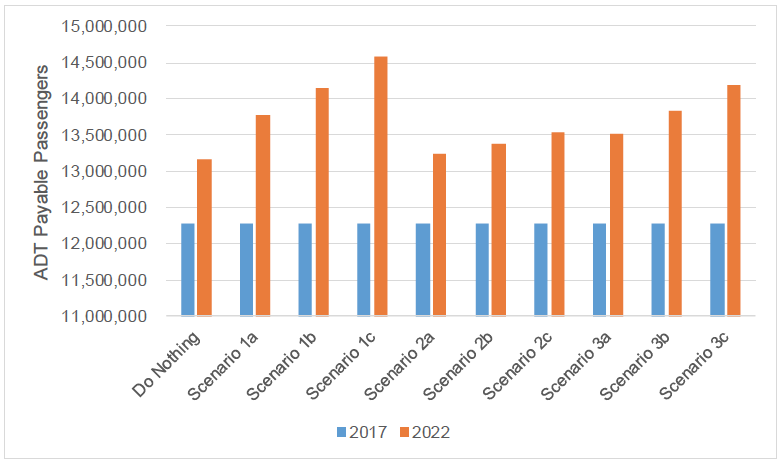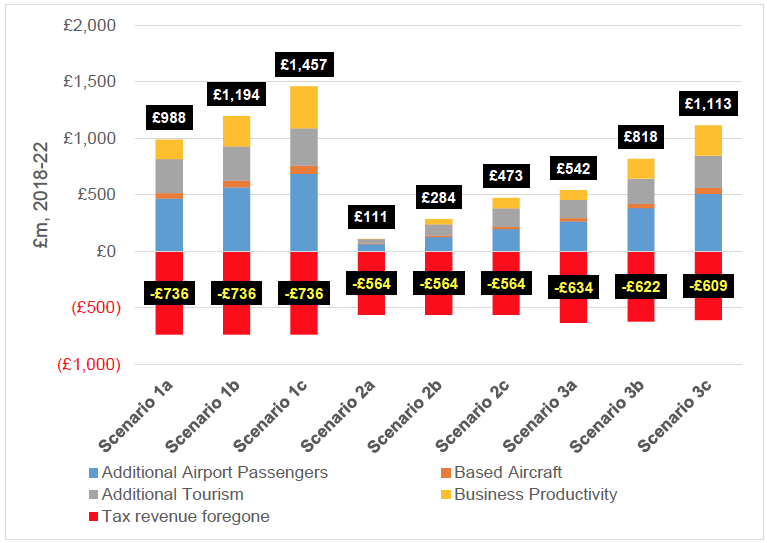Air departure tax in Scotland: an economic assessment
An economic assessment on the impact of a 50% reduction in the overall burden of air departure tax and a plan for future monitoring and evaluation.
Executive Summary
In November 2014, the Smith Commission Report recommended that the power to charge tax on air passengers leaving Scottish airports be devolved to the Scottish Parliament. It also outlined how the Scottish Government ‘ will be free to make its own arrangements with regard to the design and collection of any replacement tax, including consideration of the environmental impact’. Peter Brett Associates LLP ( PBA) and Northpoint Aviation were appointed by the Scottish Government to undertake an independent assessment of the economic impact of reducing by 50% the current tax charged at the UK level via Air Passenger Duty ( APD), in the form of the new Air Departure Tax ( ADT).
Previous analysis of changes to the levels of the existing APD has tended to focus on the market response to tax cuts being to ‘pass on’ the tax reduction to passengers in the form of lower fares. This study has recognised that the air industry’s response to changes in the tax regime will be more complex and unpredictable than this, and is most likely to comprise both (i) a degree of lower taxes being passed on to customers in the form of reduced fares; and (ii) an element of supply side response in the form of operating existing routes at a higher intensity or commencing new routes in recognition of the lower cost to the airline. As such, the latter response is also a key part of the policy of encouraging greater connectivity from Scotland’s airports to short and long haul destinations not currently served directly from Scotland.
As a decision on the precise form of ADT is yet to be taken, for the purposes of analysing the potential range of outcomes, three hypothetical tax scenarios were provided by the Scottish Government to represent potential ADT regimes for Band A (0 to 2,000 miles) and Band B (over 2,000 miles) tax rates as follows:
- Scenario 1: 100% cut in Band A (short haul), no change in Band B (long haul);
- Scenario 2: 100% cut in Band B (long haul), no change in Band A (short haul); and
- Scenario 3: 50% cut in Band A (short haul) and 50% cut in Band B (long haul).
Again for the purposes of assessing a range of outcomes, under each of these scenarios, three variants were tested with respect to the degree to which the tax reduction is ‘passed through’ to fares as follows:
- Full pass-through of tax reduction by airlines to fares (100%);
- Partial pass-through of tax reduction by airlines to fares (50%); and
- No pass-through of tax reduction by airlines to fares (0%).
It has also been assumed that as the degree of ‘pass-through’ reduces, the supply side response in the form of new routes and connections increases (since a straight pass-through of the tax reduction to fares would be essentially cost neutral to the airline). A range of supply side scenarios were therefore developed, differentiating the likely response of different airline types based on consultation with the industry and bespoke illustrative route modelling undertaken using the industry-standard APEX model. [1]
A highly segmented representation of forecast ‘business as usual’ passenger volumes (i.e. no change in tax from the current level) for each of Scotland’s airports (split by journey purpose, passenger nationality, airline type and passenger destination) was developed. Where the tax reduction is assumed to be passed on in full, or in part in the form of lower fares, a range of price elasticities of demand [2] were applied to generate a forecast of additional passenger volumes resulting from lower fares. Where the scenario implied a supply side response, assumed passenger uplifts were applied by airline type.
For each of the nine scenarios modelled, the application of lower fares and / or supply side response resulted in:
- A reduction in tax revenue in the region of the 50% advocated in the policy, noting that in some cases the reduction in revenue from existing passengers may be being offset to some extent by additional passengers, generating additional new tax revenue; and
- An increase in passenger numbers by market segment which differs widely by scenario.
The increase in tax-paying departing passengers associated with each scenario is shown in the figure below for a 2022 forecast and the base year. Note that the term ‘Do Nothing’ here refers to the scenario where current APD levels are retained in the new ADT.

The biggest increase in passenger numbers is associated with Scenarios 1c, 1b and 3c. These scenarios are wholly or in part focussed on cutting short haul tax, as this market segment is far larger and hence applying proportional demand uplifts creates the biggest impacts.
The forecast change in passenger numbers by type was then used to generate estimates of the economic impact of these increased passenger numbers using measures of employment and Gross Value Added ( GVA). There are four primary areas of impact associated with additional passenger numbers:
- Operational impacts (1): the economic activity associated with changes in the operations of airports and air services in Scotland resulting from increased passenger throughput;
- Operational impacts (2): the economic activity associated with additional ‘based aircraft’ in Scotland stemming from airlines basing more aircraft in Scotland and hence generating local employment;
- Tourism / visitor impacts: employment supported by increased inbound tourism as a result of greater connectivity and / or lower fares; and
- Wider business impacts (i.e. productivity): improvements in the long-term productivity level due to increased numbers of business passengers, reflecting improved access to foreign markets etc.
The results of this analysis for the nine scenarios is summarised in the figure below with respect to the ADT tax position and the estimated GVA impacts, summed over a five-year period. Whilst it is not a direct comparison, the figures here do give a feel for the potential foregone tax and additional Scotland level GVA in each case. In five of the nine cases, the figure for additional GVA is in excess of the tax foregone, suggesting that the tax cut under these permutations would have a net positive effect.

In terms of the scenarios developed here, the greatest economic impacts are therefore associated with Scenario 1c – a 100% cut in Band A, which assumes no reduction in fares and a substantial supply side response in the short haul sector [3] . This in turn generates the largest increase in passenger numbers and hence the biggest economic impact. If the tax cut was focussed only on Band B (long haul) the analysis here suggests that the additional GVA in this initial five-year period would not offset the loss of tax revenue.
Any analysis such as this is subject to a range of caveats and uncertainties. These have been set out in this report but should be borne in mind when interpreting the results. The key uncertainties here are:
- the level of supply side response in the shape of new routes, and the demand response to these supply uplifts which we have assumed to be perfectly elastic (i.e. of an airline puts on a new route, it will be utilised at the rate of existing routes);
- the response of passengers to lower fares (i.e. the elasticities used);
- the underlying growth scenario which may prove too optimistic or pessimistic – we have used a ‘core’ forecast and undertaken sensitivity tests around this;
- the degree of any ‘leakage’ brought about by additional overseas travel by Scotland’s residents;
- the way in which the tax cut feeds through into responses by both airports and airlines (aside from new routes);
- the potential for more or fewer additional based aircraft than assumed here, especially in the context of an expansion of low cost long haul;
- developments within aviation, particularly the growth trajectory of the potential ‘disruptor’ of low cost long haul and its impact on ‘traditional’ carriers; and
- the wider picture with respect to the UK economy and Brexit.
Contact
Related information
There is a problem
Thanks for your feedback